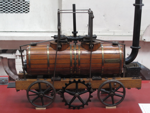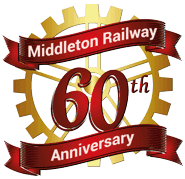Projects
The "Picton Shelter" (Construction)
 The major part of the project to conserve Picton, which is financed by a grant from the Heritage Lottery Fund, is the construction of a building, known as the Picton Shelter, which will both shelter and display Picton and house at least one other locomotive.
The major part of the project to conserve Picton, which is financed by a grant from the Heritage Lottery Fund, is the construction of a building, known as the Picton Shelter, which will both shelter and display Picton and house at least one other locomotive.
A previous page described the preparations for constructing this shelter, including the laying of a special siding for Picton to stand on, the construction of the foundations for the shelter, and finishing with the lifting of Picton to move it onto this siding. The picture below shows it in place on this siding, ready for construction work to begin.
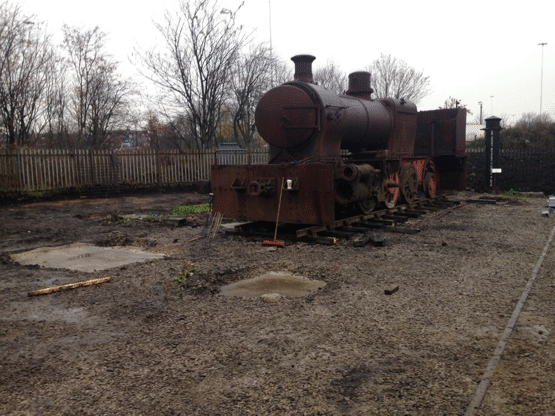
On the next day after the lift (the Tuesday before Christmas, 20th December) all the parts for the frame of the building were delivered, and spread out on the car park, as shown in the picture below.
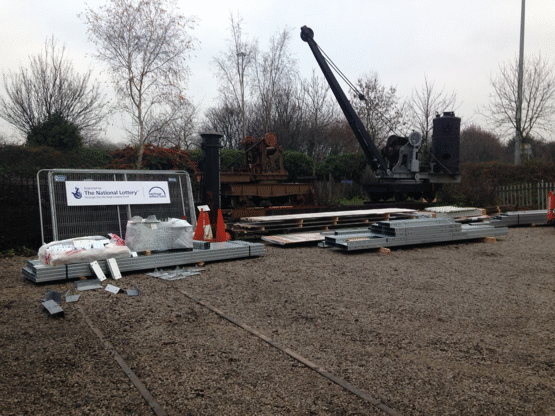
As the various parts were sorted out they were moved into place, as shown in the picture below, ready to be fastened to the brackets that were being attached to the foundation blocks.
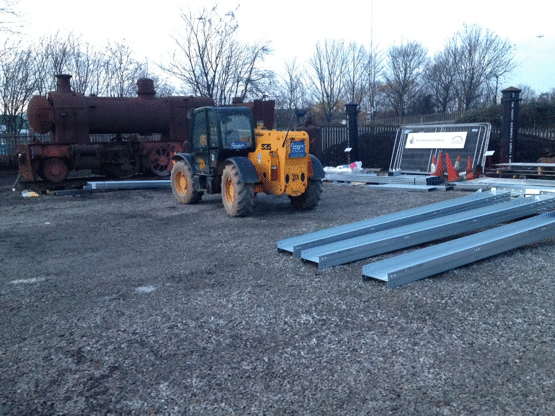
By the end of Tuesday, most of these brackets had been fixed into place, as shown in the picture below, and the frame sections were ready to be lifted into place and attached to them.
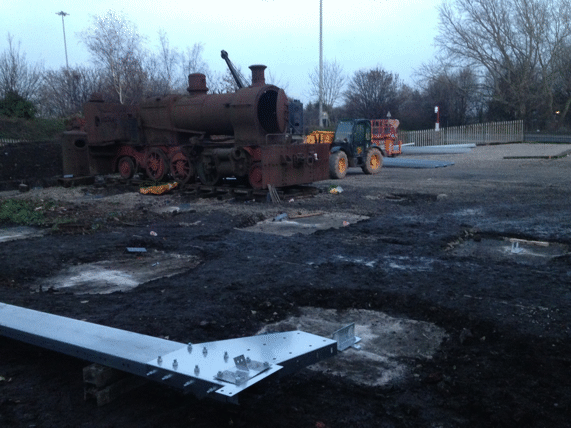
During Wednesday (21st December) the uprights for the frame were lifted into place, and the sheeting rails that connect them fitted. The picture below shows where this had got to by the middle of the day, with four out of the five uprights for the west wall of the building in place.
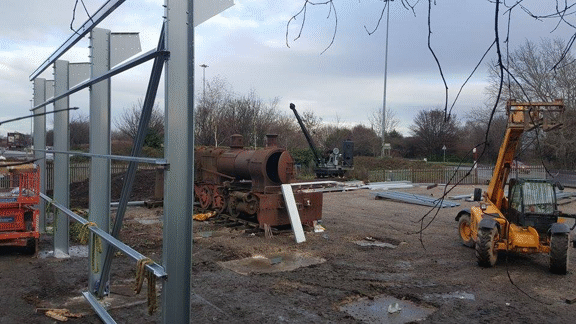
By the end of Wednesday the frame for the west wall was complete, and three of the uprights for the centre wall were in place, as shown in the picture below.
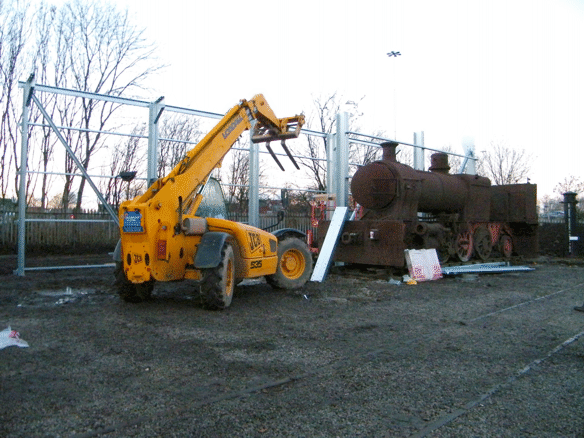
By the end of Thursday the frame had been completed, as in the picture below, which also shows some of the machinery used to erect it.
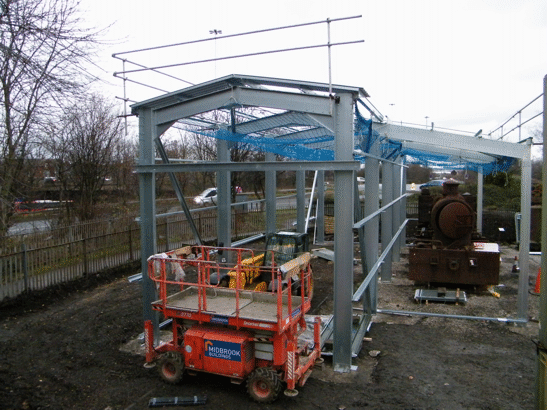
The picture below is taken from the car park, and shows Picton in the shelter. The railings round the roof girders, and the netting between them, are for the safety of the workers when they come to fit the roof cladding sheets.
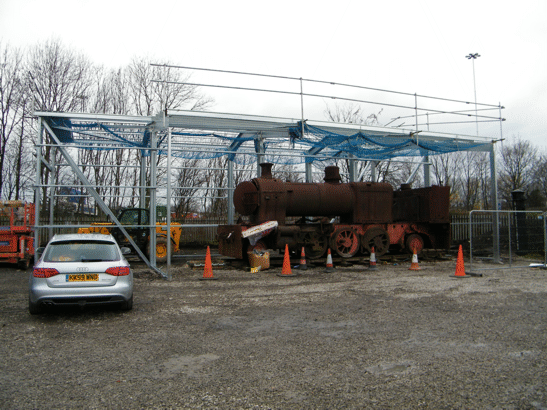
The picture below shows a front view of Picton in the shelter.
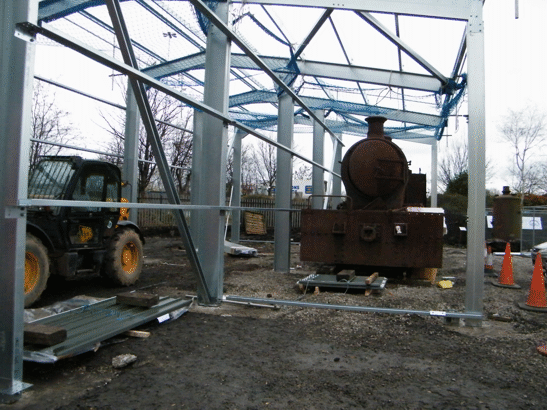
And the picture below is the equivalent view from the rear of Picton.
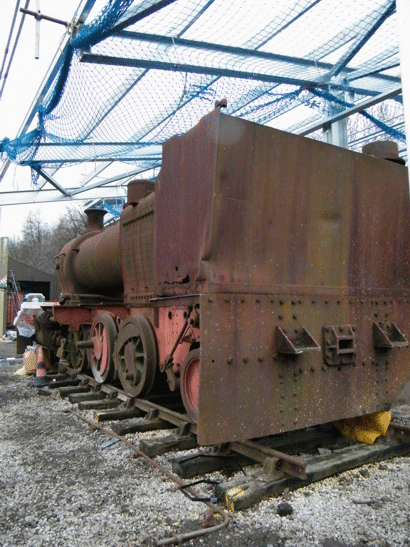
The whole Picton shelter building will be clearly visible from the motorway roundabout, as shown in the picture below. The yellow object that can be seen through the shelter is the Greenbat electric locomotive, but this will not be visible once the cladding of the shelter has been fitted.
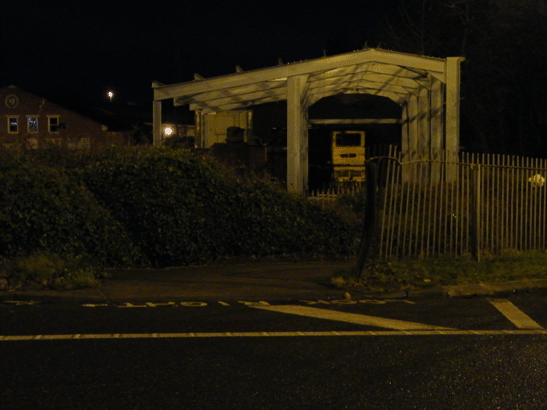
After Christmas work resumed on fitting the cladding to the frame, and the picture below shows the roof cladding being installed.
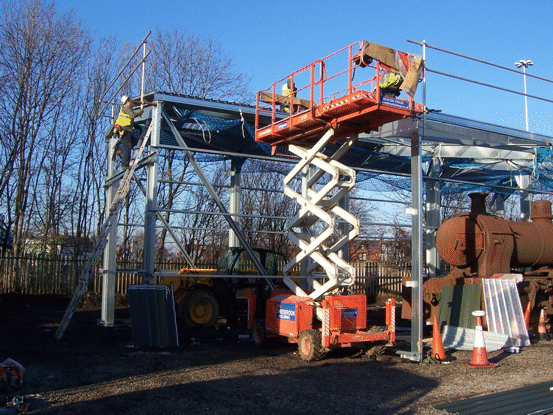
By the end of December most of the cladding had been fitted, as shown in the pictures below. The main bit that was still to be installed was the wall that separates Picton from the shed part of the shelter.
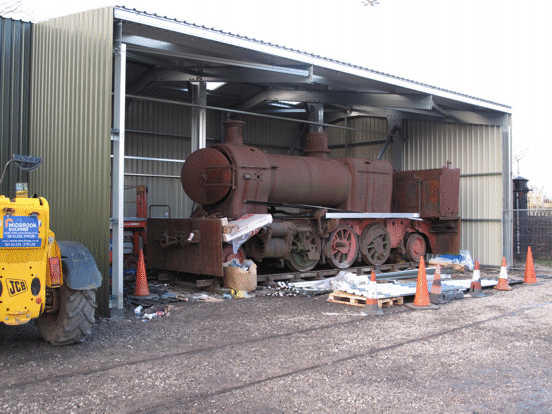
The picture below shows the view in from the south end of the shed part of the shelter, with the scissor lift parked inside it. The absence of the cladding that will separate this part of the shelter from Picton itself is very noticeable.
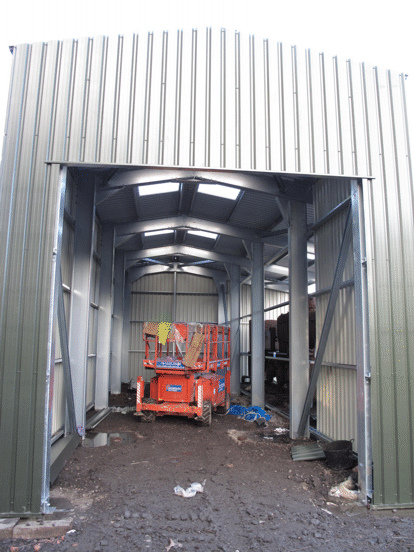
In the first week of January the rest of the cladding was fitted, and the picture below shows Picton with the wall cladding behind it.
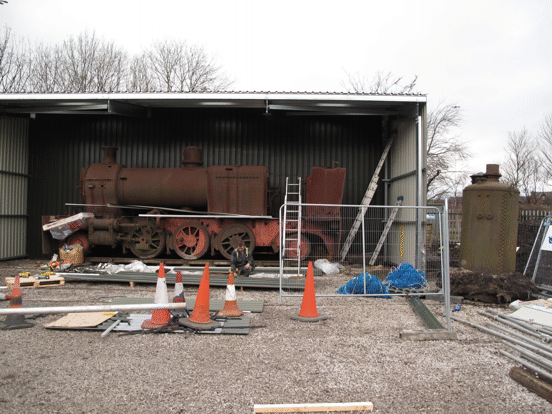
And here is the view in from the south doorway.
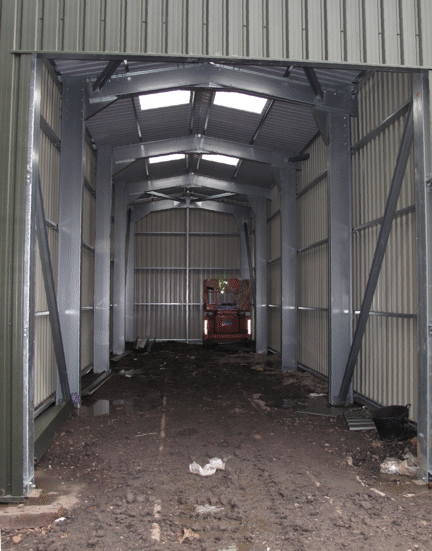
By the end of that first week in January all the guttering, flashing and other details had been fitted, as shown in the picture below, and just the doors still needed to be installed. At this point the cladding still covered where the personnel doors would go.
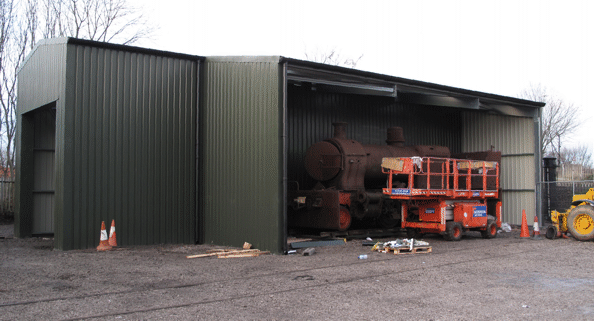
The doors were fitted the following week, and the picture below clearly shows one of the two personnel doors in the completed shelter: the other is at the north end of the building.
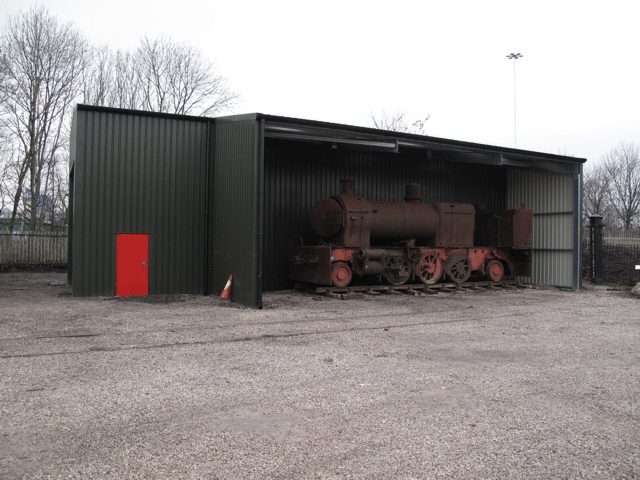
As well as the personnel doors, the roller shutter door for the south end had also been installed, and the picture below shows this partly closed. Opening and closing it will be easier once a power supply to the building has been installed!
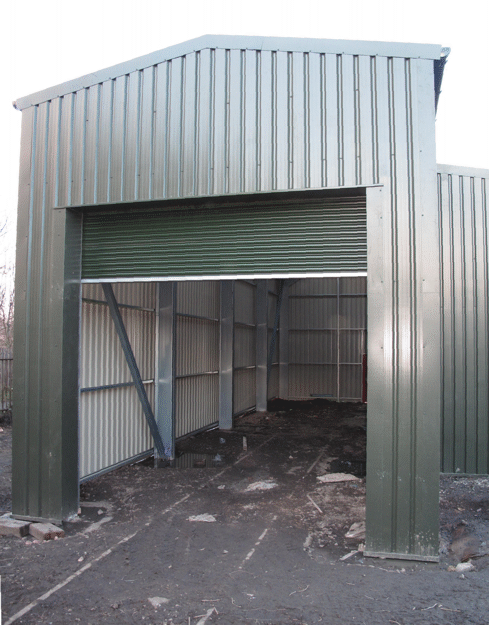
With any construction project, when it reaches this stage there are likely to be some snags to be sorted out, and this building is no exception. The main snag is that some of the ground round the building is still slightly higher than the tops of the foundation blocks, and so water is tending to collect round these blocks. A bit of careful digging will therefore have to be done to lower the ground levels. The other snag is that the unmade ground does not really provide a satisfactory floor inside this part of the building, and so some of this will be removed and replaced by ballast.
Also, when the contractors removed their site fencing panels they took with them the Heritage Lottery Fund board which had been attached to one of the panels. We still have a second board, and this needs to be fitted permanently inside the shelter, so as to acknowledge their funding of its construction.
Watch this space for further progress!
Go back to the previous stage in this project.
Return to the overall description of this project.
More Information
Other pages about this project:
- Conserving Picton.
- Preparation for constructing the "Picton Shelter";
Other pages provide more information about:
Running Shed Phase 4 (Construct Foundations)
As described in the page for the structure of the whole project, the Running Shed is being built in seven phases. The first three phases were all concerned with preparation for the actual construction work, and after various delays this work finally commenced on 31st May 2016 - at 6.00am, no less!
The first step was to bring the necessary plant onto site, and the picture below shows Midbrook Steel's dumper track running up through what is normally our security compound, closely followed by their excavator. The dumper truck is carrying a load of metal fencing panels that were used to make the construction site secure.

Construction plant arriving on site.
Picture © Mark Calvert, 2016. Taken at 6.10 in the morning on the first day of construction work!
Once established on site the contractors wasted no time, but of course for constructing foundations you have to start by digging down before you can build up. So, the first step was for the excavator to start digging the trenches for the foundations on the east side of the running shed, and by mid morning good progress was being made, as shown in the picture below.
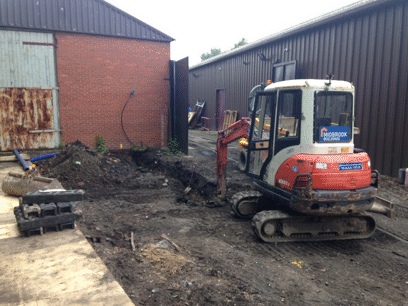
Midbrook Steel's excavator digging out the foundation trench for the east wall of the running shed. Note the covered pit on the left-hand side of the picture.
Picture © Mark Calvert, 2016.
By the end of Tuesday the trench was complete, but it needed to be checked by the building inspector. He came on Wednesday, and gave permission for the concrete to be poured, so later that day three lorry loads of it were delivered. Then a fourth lorry load was needed on Thursday morning (2nd June), to finish off the foundations for this side of the shed, and the picture below shows this fourth load being poured.
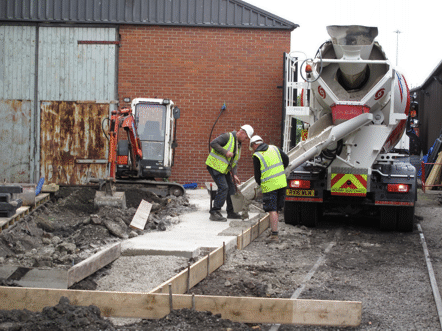
Concrete being poured for the east side foundations.
Picture © Tony Cowling, 2016.
Once this load of concrete had been poured, and then the top smoothed off, attention switched to the west side. The picture below shows the trench for this side being dug, on the Thursday afternoon.
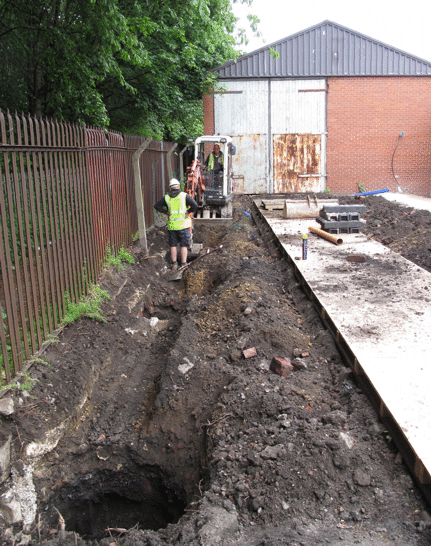
Excavating the foundation trench for the west side of the running shed.
The first two of the deep parts of the trench are clearly visible, and the excavator is working on the third. These deep parts are for the portions of the concrete that will support the uprights of steel frame.
Picture © Tony Cowling, 2016.
By Tuesday of the following week this trench had been completed, the building inspector had checked it and given permission to proceed, and the concrete had been poured. The picture below shows it with the shuttering still in place, but once the concrete had set to the point where the shuttering could be removed then the foundations were complete.

The foundations for the west side of the running shed, after the concrete had been poured but with the shuttering still in place. The blue pipe that feeds the water tower can be seen suspended from the fence posts, to ensure that it did not get buried in the foundations.
Picture © Mark Calvert, 2016.
As soon as the work on the foundations had reached a stage where the pit could be used, then it was, as shown in the picture below. This was taken during the model railway exhibition, where "Driver for a Fiver" was being operated, which is why there is a yellow flag and a red flag visible between the rails of the track on the right of the picture, to mark the limits of the operation.
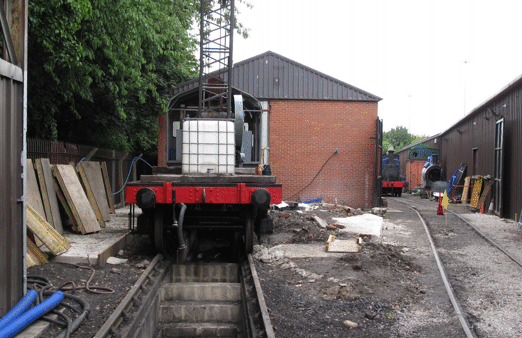
The crane and the ex-Hunslet flat wagon (with a large water carrier on top of it) standing inside the area of the running shed, with the completed foundations visible on both sides.
Picture © Tony Cowling, 2016.
The next step was to install the oil separator, which was done between 13th and 15th July 2016, fitting round the preparations for our Victorian Gala on 16th and 17th July. The oil separator is a large unit, as shown in the picture below, where it is on the ground in the security compound, waiting for the hole to be dug for it.
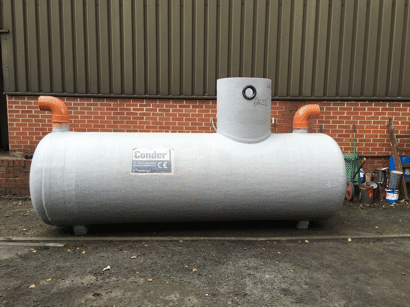
The oil separator, waiting to be installed.
Picture © Janet Auckland, 2016.
Meanwhile, Drainstore (who had supplied the separator) were excavating the hole for it, as shown in the picture below. Eventually the hole would be nearly 3 metres (9 feet) deep.
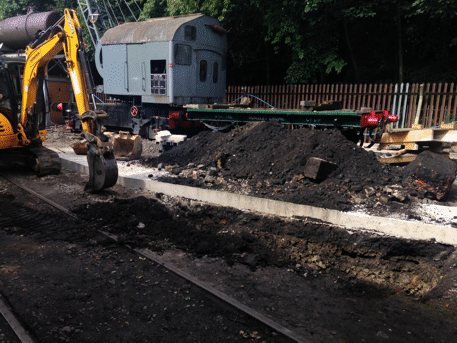
Excavating the hole for the oil separator, between the foundations of the running shed and the track into the security compound.
Picture © Mark Calvert, 2016.
Once the hole had been excavated, then dry concrete needed to be laid into the bottom of it, for the separator to sit on, and the picture below shows the dry concrete being delivered. Once the bottom layer had been laid, then the separator could be lowered into the hole, as shown in the picture below that, and more dry concrete tipped round it to hold it in place.
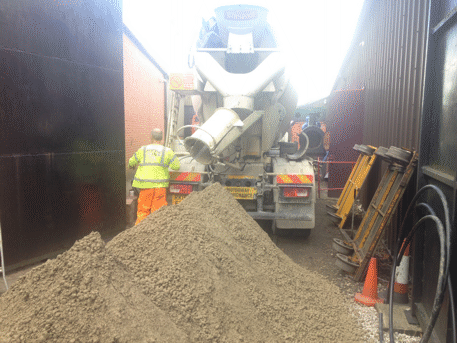
The dry concrete being delivered.
Picture © Mark Calvert, 2016.
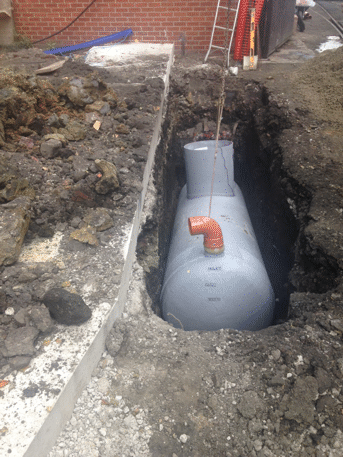
Lowering the oil separator into the hole.
Picture © Mark Calvert, 2016.
Once the oil separator was securely in place, then the inlet pipe from the pit and the outlet pipe to the drain could be connected up, and the chambers for the pump and outlet constructed on top of it. The manhole covers for these were then fitted, and in the picture below they are all that can be seen of the separator.
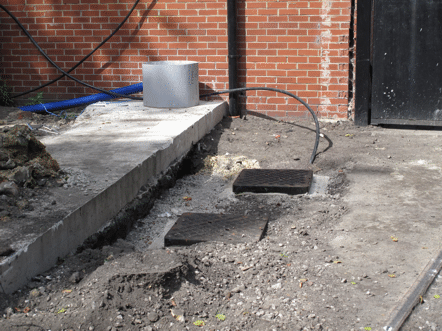
The oil separator installed, with just the manholes visible.
Picture © Tony Cowling, 2016.
This completed the construction of the foundations, and once the spoil had been cleared everything was ready for erection of the framework to start.
Go on to the next stage in this project.
Go back to the previous stage in this project.
Return to the overall description of this project.
More Information
Other pages about this project and the "Buy a Brick" appeal:
- An overview of the project and the appeal;
- The "Buy a Brick" appeal;
- The structure of the project;
- The progress with the project;
- The construction of the pit;
- Design and site preparation;
- Erection of the framework;
- Construction of the walls;
- Fitting out;
- The opening ceremony.
Other pages provide more information about:
Conserving "Picton"
 As part of a successful Heritage Lottery Fund bid, the Middleton Railway has embarked on a project to conserve Picton (Hunslet 1540 of 1927), illustrated below. This locomotive forms an important part of the Leeds locomotive building story and our history, having been built less than a mile from the railway. It was part of a range of standard locomotives that was developed by Hunslet’s specifically for export, which differed from the range of 0-6-0 saddle tanks that they built of industrial use in the UK (such as Brookes No. 1, whose overhaul is also funded by the same lottery bid) by having outside cylinders and side tanks. They also had a variety of wheel arrangements (Picton is a 2-6-2), and were built for a variety of gauges (although Picton is for standard gauge track, but it is significantly wider than a standard gauge locomotive for UK use would be).
As part of a successful Heritage Lottery Fund bid, the Middleton Railway has embarked on a project to conserve Picton (Hunslet 1540 of 1927), illustrated below. This locomotive forms an important part of the Leeds locomotive building story and our history, having been built less than a mile from the railway. It was part of a range of standard locomotives that was developed by Hunslet’s specifically for export, which differed from the range of 0-6-0 saddle tanks that they built of industrial use in the UK (such as Brookes No. 1, whose overhaul is also funded by the same lottery bid) by having outside cylinders and side tanks. They also had a variety of wheel arrangements (Picton is a 2-6-2), and were built for a variety of gauges (although Picton is for standard gauge track, but it is significantly wider than a standard gauge locomotive for UK use would be).
As such, Picton is a rare example, because there are very few representatives of this range of locomotives left in this country, precisely because nearly all of them were exported. It was one of a batch of three built for export to a sugar mill in Trinidad, where it spent the whole of its working life. It was discovered there by David Monckton, a former chairman of the Middleton Railway Trust, along with the other two from the same batch. He recognised its importance as a representative of this range of exported locomotives, and he was eventually able to select it as the best of the three survivors, re-import it back into the UK, and bring it to the Middleton Railway.
The picture below shows Picton when it first arrived at the Middleton Railway, with its wheels still attached to the lengths of rail on which it had been mounted for transport (it came from Trinidad as deck cargo on a banana boat). Still clearly visible on the wheels are the remains of the Brunswick Green paint that was the standard Hunslet colour scheme for locomotives where the new owners did not specify that their own livery was to be used.
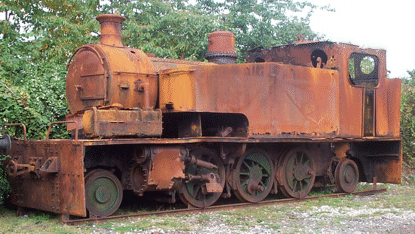
When Picton first arrived at the Middleton Railway there were some suggestions that it should be restored to working order, but these did not last long once it was realised that the locomotive's bufferbeams are so wide that they would demolish the railway's platforms. Also, once the locomotive was inspected carefully it quickly became apparent that so much of it would have to be replaced that this would be more a matter of building a replica than restoring the original. Indeed, this inspection revealed that the tanks and cab were so badly corroded that they were actually dangerous, and they had to be taken off the locomotive.
Thus, when the Middleton Railway set up its project to acquire Brookes No. 1 and Picton from David Monckton and then conserve them, the most that could realistically be done for Picton was firstly to coat it with preservative (having prepared the surface of the metal by shotblasting it), and then to construct a building to protect it from the elements. The construction of this "Picton Shelter" building is thus a major part of this conservation work, and separate pages give more detail of the construction of this shelter.
Go on to the next stage in this project.
More Information
Pages about other projects:
- Last Coals to Leeds;
- Raising Steam in No. 6;
- Project Phoenix;
- Building a Running Shed;
- Overhauling "Brookes No. 1".
Other pages provide more information about:
- Our portfolio of development projects;
- Our museum collection;
- How you could get involved;
- What we offer for visitors;
- Our train services;
- How to find us.
Development Projects
When the Middleton Railway Trust started in 1960 it had very little in the way of resources, and so it had to develop in order to survive. Those early development projects could only be small-scale ones - a bit of track relaid here, or a bit of maintenance work on a locomotive there - but as the railway has grown so too has the scale of the projects that it could undertake. Indeed, much of the work that constituted "a project" then would now be regarded simply as routine maintenance.
These pages therefore focus just on major development projects, with a particular emphasis on the ones that are currently taking place or have been completed recently, although eventually pages will also be created here to describe some other projects that had been completed previously.
Current Projects
Last Coals to Leeds
2018 is the 50th anniversary of the closure of the Middleton Broom Colliery, which until then had been the main focus of the existence of the Middleton Railway, since the railway had originally been built to carry coal from there into the centre of Leeds. The railway will be running a special event to mark this, and it will also be undertaking an educational project focused on primary schools in South Leeds, to raise awareness of the importance of the mining heritage of this part of the city.
Separate pages give more details of:
- the educational project; and
- the special commemorative event.
Raising Steam in No. 6
‘No. 6’ (Hawthorn Leslie Works number 3860) was built in 1935, and spent its entire working life at APCM's Cement Works in Swanscombe, Kent, along with six others. In 1971 they were replaced by diesel locomotives, and APCM donated No. 6 to the Middleton Railway. It quickly entered service, and played a major part in operating the railway's passenger trains, until it had had to be taken out of service in 1975 for an overhaul. The picture below shows it emerging from the tunnel under what was then the newly-constructed extension of the M1 motorway.
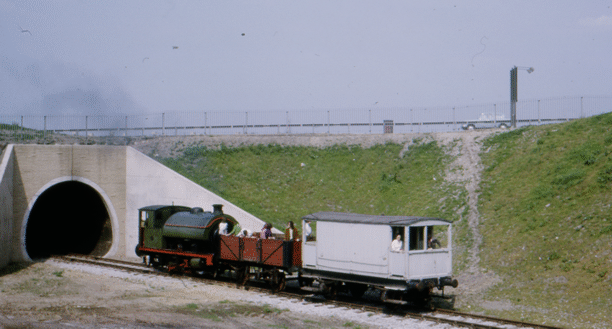
By this time there was a queue of locomotives awaiting overhaul, and No. 6's turn to enter the workshops did not come until 2001. The frames and running gear were overhauled, but then a further delay came in 2005, when the complete remodelling of the Moor Road site began, along with the construction of the Engine House building, and so work on No. 6 more or less ceased.
Meanwhile, it had become clear from an inspection of its boiler that some major repairs would be needed, and so during 2014 Gordon Newton (formerly of the boilermakers Israel Newton and Sons) visited the railway to offer advice on what work was needed, and on how much of this our members could undertake. The work that he identified has been done, and so to complete the overhaul we now have to send the boiler away to a boilermakers for the rest of the repair work. A conservative estimate is that this could cost up up to £60,000, and so we have launched an appeal for the funds needed to return No. 6 to steam by 2020, when it will be 85 years old.
Separate pages give more details of this project, and of the appeal.
Project Phoenix
During 2016 the railbus OLIVe, which is owned by our colleagues in the EM2 Locomotive Society, was the subject of an arson attack which burnt out its interior. While it was insured, the costs of actually repairing it will be significantly more than the insurance payment, and the EM2 Locomotive Society has launched an appeal for the additional funds needed to restore it to working order.
A separate page gives more details of this project and appeal.
Completed Projects
The Running Shed and "Buy a Brick" Appeal
When the railway's business plan was drawn up for the five years from 2011 to 2015, one of the proposals that had been included in it was for a project to construct a running shed, in order to improve the conditions in which operating steam locomotives were kept and prepared for service. From the outset it was clear that this project would need a significant amount of money, and so some careful financial planning would have to be the first step.
The outcome of this planning was that early in 2013 it was agreed both to set up the "Buy a Brick" scheme to raise money for this project, and to start work on planning the details of the engineering aspects of this project. The picture below illustrates the design for the bricks, and was used in the publicity material for the scheme.

Separate pages give more details of this project. It was effectively completed in December 2017, when we started to use the shed, but the formal opening ceremony for it was not until 21st July 2018.
"Brookes No. 1" Overhaul
 In 2013 we were awarded a grant of £70,650 by the Heritage Lottery Fund to acquire and conserve the David Monckton collection, which consisted of the two locomotives "Brookes No.1" and "Picton" and an archive of associated documents. A major part of this work was the project concerned with overhauling "Brookes No.1", and in particular with training our younger members in the kinds of technologies that are involved in such an overhaul of a steam locomotive.
In 2013 we were awarded a grant of £70,650 by the Heritage Lottery Fund to acquire and conserve the David Monckton collection, which consisted of the two locomotives "Brookes No.1" and "Picton" and an archive of associated documents. A major part of this work was the project concerned with overhauling "Brookes No.1", and in particular with training our younger members in the kinds of technologies that are involved in such an overhaul of a steam locomotive.
This project therefore did not just restore the locomotive to the kind of condition where it both looks as well as it does in the photograph below (where it is seen approaching Park Halt with a freight train) and runs as well as it looks. The project also equipped some of our volunteers with the skills needed to achieve the same effects in the future with other locomotives, and helped us to establish the training programme that is needed to continue these developments.
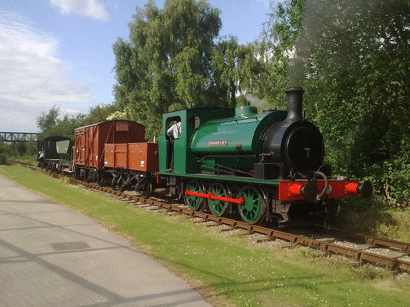
Separate pages give more details of this project. It was completed in August 2017, when the locomotive returned to service.
Conserving "Picton"
 The other main part of the work that is being financed by this grant from the heritage Lottery Fund is the conservation of "Picton". This had been brought back to the UK by David Monckton in 2002, and brought to the Middleton Railway, having previously spent all of its working life on a sugar plantation in Trnidad. If there are any pictures in existence of it working there, we do not know about them, but we do have the picture below, which shows its sister locomotive "Tarouba" at work on the same sugar plantation.
The other main part of the work that is being financed by this grant from the heritage Lottery Fund is the conservation of "Picton". This had been brought back to the UK by David Monckton in 2002, and brought to the Middleton Railway, having previously spent all of its working life on a sugar plantation in Trnidad. If there are any pictures in existence of it working there, we do not know about them, but we do have the picture below, which shows its sister locomotive "Tarouba" at work on the same sugar plantation.
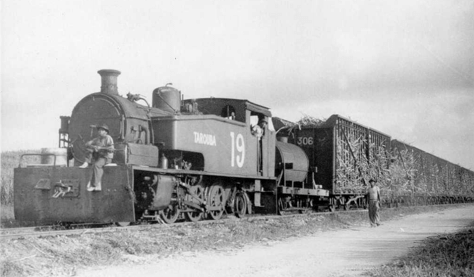
Restoring "Picton" to working order would not be a feasible proposition, and so the main part of this project is to construct a "Picton shelter" building to protect the locomotive from the elements, once it has been treated with preservative.
Separate pages give more details of this project. The part of it that was financed by the Heritage Lottery Fund was completed at the end of September 2017, although there is still some further conservation work to do on the locomotive.
Hunslet Flatbed Wagon Restoration
As part of the preparation for our special event to commemorate the 150th anniversary of the Hunslet Engine Company, we set up a project to restore this flatbed wagon which had originally belonged to Hunslet's. The restored wagon is shown below, running in the special trains for this event with the tank from "Brookes No.1" as its load.
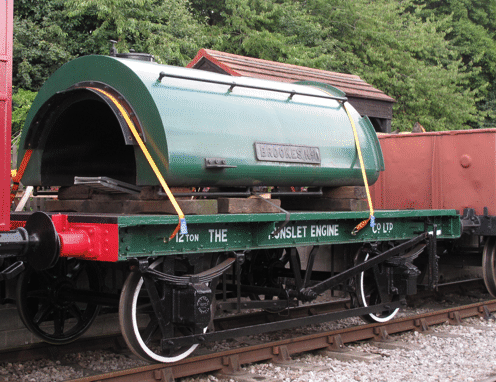
A separate page gives more details of this project.
More Information
Other pages provide more information about:
Building a Running Shed
What's a Running Shed?
A Running Shed is a building where we can both prepare steam and diesel locomotives for service indoors, and carry out light maintenance work on them. We will be building a shed that will be large enough to accommodate two operational locomotives. Here is an artist's impression of the planned shed, painted by Richard Stead, one of our members.
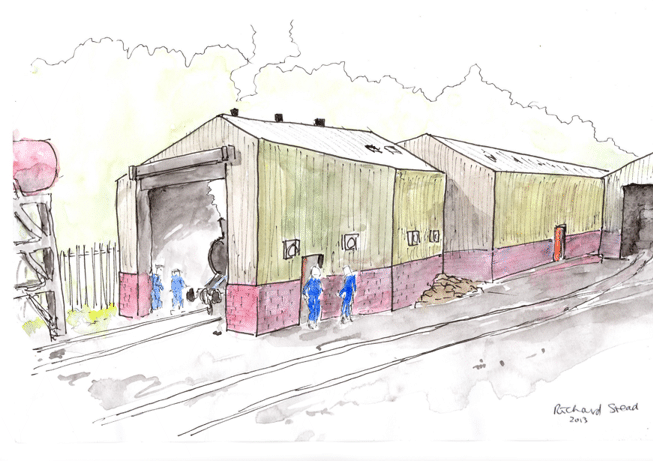
Why do we need a Running Shed?
Currently we have to prepare locomotives for service outdoors, which means they have to be stored outdoors for at least a few days before they are used. The Running Shed is being designed so that preparing locomotives, and carrying out running repairs on them, can all be done indoors. This will make the work far more comfortable, and will greatly improve the security of the locomotives.
This means that the Running Shed will better preserve our collection of locomotives, so as to allow us to keep them in the kind of condition illustrated below. As such it will help to ensure that the collection lasts for many more years into the future. The Running Shed will also give us more space in the yard and enable a better operating railway!
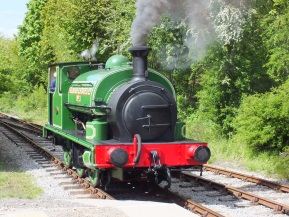
How will the Running Shed be built?
As the artist's impression above shows, the lower part of the walls of the running shed will be of brick construction, and the upper parts and roof will be of coated steel sheet (sometimes called "wriggly tin" by builders, although it is actually not tin at all!). The whole structure will be supported by a steel frame, which will rest on concrete foundations.
The shed can not be quite rectangular, because the site tapers (the two tracks shown in the impression merge at a turnout off to the left of the picture), and so the corner nearest the viewer has to taper off too. The shed will have smoke troughs and vents in the roof, so that the fumes produced while lighting the fires in steam locomotives can escape easily. Inside the shed there will be a pit between the rails, to make it easy to prepare locomotives, and there will also be another pit between the rails outside it (which is not shown in the impression), to simplify disposing of ash from steam locomotive fireboxes at the end of a day's operation.
These requirements mean that the process of constructing the shed will actually involve seven phases. A separate page describes how the project is structured, and the details of these phases.
When will the Running Shed be built?
Part of the answer to this is "when we have raised enough money to start", but the other part of the answer is that how long the work will take will depend on how much of it we do ourselves and how much is done by contractors. Doing the work ourselves, using our volunteer labour, is obviously cheaper than having to employ contractors, but it is also significantly slower. Some parts of the work do, however, need to be done by skilled contractors: erecting steel frames or fixing cladding sheets to them, possibly 15 feet up in the air, is not a task for amateurs! On the other hand, laying the bricks for the walls is something that we know our volunteers can do, although offers of help from experienced bricklayers would certainly be welcome!
A separate page describes the progress that we have made so far, and then other pages give more details of the work that has been done for individual phases of the project. We had hoped to see the project more-or-less finished by the end of 2016, but it actually ran on until nearly the end of 2017, and then we organised an opening ceremony in 2018.
How can you help?
There are two main ways in which you might be able to contribute to this project.
Firstly, even doing as much of the work ourselves as we can, we shall still need to raise quite a lot of money to build the Running Shed: the initial estimate was at least £46,000, and that has now gone up to about £48.000. A separate page describes the "Buy a Brick" appeal that we were running, to help raise funds to cover this cost, but this appeal has now closed.
Secondly, the parts that we can do ourselves will involve our volunteers working in all sorts of ways to contribute to the project. You can see some of these ways in the separate pages describing the work that has been done so far; there was a lot of bricklaying involved; we still have a floor to lay; we shall be installing all the electrical wiring and other fittings; and so on. If you have almost any kind of practical skill we will probably be able to use your help in this project. Please see our separate membership page for more details of how to get involved.
Go on to the next stage in this project.
More Information
Pages about other projects:
- Last Coals to Leeds;
- Raising Steam in No. 6;
- Project Phoenix;
- Overhauling "Brookes No. 1";
- Conserving "Picton".
Other pages provide more information about:

